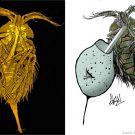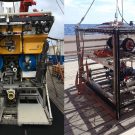(English version below) Tief, fremd und unbekannt: So wird die Tiefsee häufig beschrieben. Die meisten der Tiere in der dunklen Tiefseeebene 4000 Meter unter unserem Schiff sind bisher unentdeckt und nur wenige wurden wissenschaftlich beschrieben. Hier möchten wir einige der Arten vorstellen, die wir während der Fahrt SO268 bereits entdeckt haben oder von denen wir […]
BOBO and the 7 (+7) dwarfs: How to sense the deep sea
by Sabine Haalboom (NIOZ) The first half of the cruise has passed and we’ve finished the baseline studies in the Belgian license area. Doing my PhD research in marine geology at the Royal Netherlands Institute for Sea Research (NIOZ), my main interest is the particle dynamics in the bottom boundary layer (i.e. the layer close […]
Glimpsing through the eyes of deep-sea cameras/Ein Blick durch die Linse von Tiefsee-Kameras
– The Ocean Floor Observation System (OFOS) and Remotely Operated Vehicle (ROV) – (deutscher Text siehe unten) Many samples that marine biologists gather during research cruises are taken “physically”, such as deep-sea mud that is heaved up from the seafloor onto the deck via different coring gears, and gets further processed in the labs. With […]
Schätze der Tiefsee / Treasures of the Deep
(English below) Manganknollen – Entstehung und wirtschaftliche Relevanz von Jessica Volz, Sophie Paul und Julia M. Otte Während der ersten globalen Forschungsexpedition der HMS Challenger in den 1870er Jahren wurde das große Ressourcenpotential der Tiefsee deutlich. An Bord der HMS Challenger wurden zahlreiche unbekannte marine Organismen sowie mineralische Konkretionen vom pazifischen und atlantischen Meeresboden, die […]
The Archimedes-I cruise: back to port
+++ Für die deutsche Version bitte nach unten scrollen +++ All good things come to an end and so is the Archimedes-I cruise. For 48 days, 39 scientists and 31 crew members were onboard of the RV Sonne, cruising the Lau Basin in the south-west Pacific. The cruise was one of a kind because in […]
Between a rock and a hard place…
Just as most scientists, geologists spend most of their working time in front of a computer (i.e., the hard place) – sometimes interrupted by some time in the lab, depending on your specialty. The best thing about Geology though is that we have to go into the field or on research cruises like this one, […]



